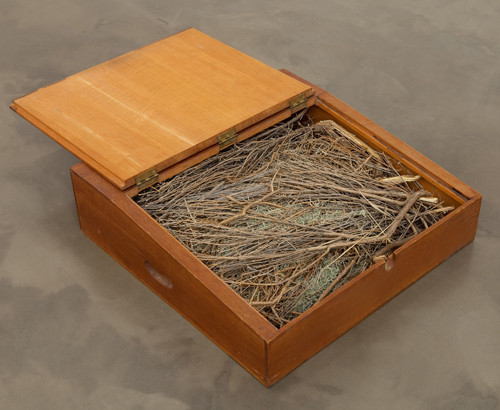ROBERT KINMONT
Trying to understand where I grew up: Born in Los Angeles in 1937, conceptual artist Robert Kinmont spent his early years outside the small rural town of Bishop, California, before settling in Sonoma, his home of over 30 years. The artist’s approach and process have continuously been informed by his deep connection to the California landscape, evident in the recurrent use of natural elements such as wood, dirt, copper, and water. In the 1970s, Kinmont took a 30-year hiatus from his art practice to study Zen Buddhism and work as a carpenter.
Trying to understand where I grew up profiles his prolific art-making periods before and after this break, including some works exhibited for the first time. The exhibition also marks the first Bay Area solo presentation by the artist in over 45 years, providing a unique opportunity to view Kinmont’s evolution from early works of the late 1960s and ’70s to those following his reemergence in 2005. Through works in photography, sculpture, and video, Kinmont explores the interdependency between man and nature. Taken as a whole, the four elements Kinmont considers essential to his artistic language—the conceptual, structural, natural, and civic—remain common threads throughout the artist’s body of work.
Robert Kinmont, 8 Natural Handstands (detail), 1969/2005. 9 silver gelatin prints, each 8 x 8 in.
Robert Kinmont, Sit on the floor, 1971. Wood and sage, 6.75 x 23.75 x 23.5 in. Courtesy of Alexander and Bonin Gallery, New York.
Robert Kinmont, Listen (installation view), 2013. Plywood, paper, metal, photographs, glass, and wire, 96.5 x 145.5 x 26.5 in. Courtesy of the artist and Alexander and Bonin Gallery, New York. (Photo: Wilfred J. Jones)
Robert Kinmont, Trying to understand where I grew up, 1975. 3 color photographs, tape, tape residue, and pencil mounted on Fuji crystal archive paper in 2 parts, 9.25 x 19 in. Courtesy of Alexander and Bonin Gallery, New York. (Photo: Wilfred J. Jones)
Robert Kinmont, 127 Willow Forks (This is Who I Am), 2010. Willow, pine, birch plywood, and maple, 84 x 153 x 45 in. Courtesy of the artist and Alexander and Bonin Gallery, New York. (Photo: Wilfred J. Jones)
Robert Kinmont (b. 1937, Los Angeles) currently lives in Northern California.
Between 1968 and 1981, he exhibited in galleries and institutions such as the San Francisco Museum of Art; the de Young Museum, San Francisco; the Smithsonian Institution, Washington D.C. and the 1968 “Sculpture Annual” at the Whitney Museum, New York. Between 1975 and 2004, Kinmont studied Buddhism and worked as a carpenter, returning to his artistic practice in 2005.
One-person exhibitions of his sculpture and photography took place at Alexander and Bonin in 2009 and 2011, and in 2010 his work was included in several group exhibitions such as “The Traveling Show”atFundación/Colección Jumex, Mexico City, and “The Moon is An Arrant Thief”at the David Roberts Foundation, London. In 2013, the artist’s work was included in “Plans for Escape: An Exhibition under Construction,” at the Centro Cultural Banco do Brasil in Sao Paulo.
In 2011, Kinmont’s work was included in “State of Mind,” a survey of new California art circa 1970 co-organized by the University of California, Berkeley Art Museum and the Orange County Museum of Art. In 2012 his work was included in “Ends of the Earth: Art of the Land to 1974,”at the Geffen Contemporary at the Museum of Contemporary Art, Los Angeles; the exhibition subsequently traveled to Haus der Kunst, Munich. In 2014, Alexander and Bonin presented a solo exhibition of new sculpture, “trying to return home educated.” The following year, Kinmont had two solo exhibitions; “Jump” at RaebervonStenglin, Zurich and “Robert Kinmont: trying to understand where I grew up” at the di Rosa museum in Napa, CA. Also in 2015, his work was included in “Afterlife”, curated by Julie Ault, at Galerie Daniel Buchholz, New York. Kinmont’s photographic series 8 Natural Handstands,1969/2009 was included in “Sublime – The tremors of the world” at the Centre Pompidou-Metz in 2016. That same year, his work was included in “Full Moon,” the inaugural exhibition at Museum Voorlinden in Wassenaar, The Netherlands.
In May 2017, a solo exhibition of Kinmont’s work opened at Alexander and Bonin.
“This is my favorite dirt road. It goes up to Buttermilk and is mostly washboard and straight. It’s a modern dirt road, wider than most dirt roads. You can do fifty miles an hour on it. It’s sandy on the sides.
I learned to drive on it and we used to go up it in the winter to count deer and hunt cottontail rabbits. I’ve ridden a horse up it and walked down it and lost a wounded deer by it and watched miners set dynamite charges to improve it.
I’ve looked for chucker partridge, shot at quail, doves, done water colors of the rocks beside it under the trees over it, know one of the only unclaimed springs by it and watched mountain lions run away from it.
It leads to a road that goes to hanging valley mine behind the top of Mount Tom, to Horton Lakes, to the artists’ cabin, to the beaver ponds, to the place where they count deer in the winter, to the cattle guard, to the miners’ cabin, to the top of the sand canyon, to the Basin Mountain Mining road, to the Rocking Chair Ranch, and starts from one of the only recorded spots of a battle between Paiutes and Whites, almost exactly where the stream that crosses the desert from Bishop Creek leads to the ranch where I grew up.”
Much I have excerpted from various sources.
Please note that I do not own the copyright to most of the texts, images, or videos.








